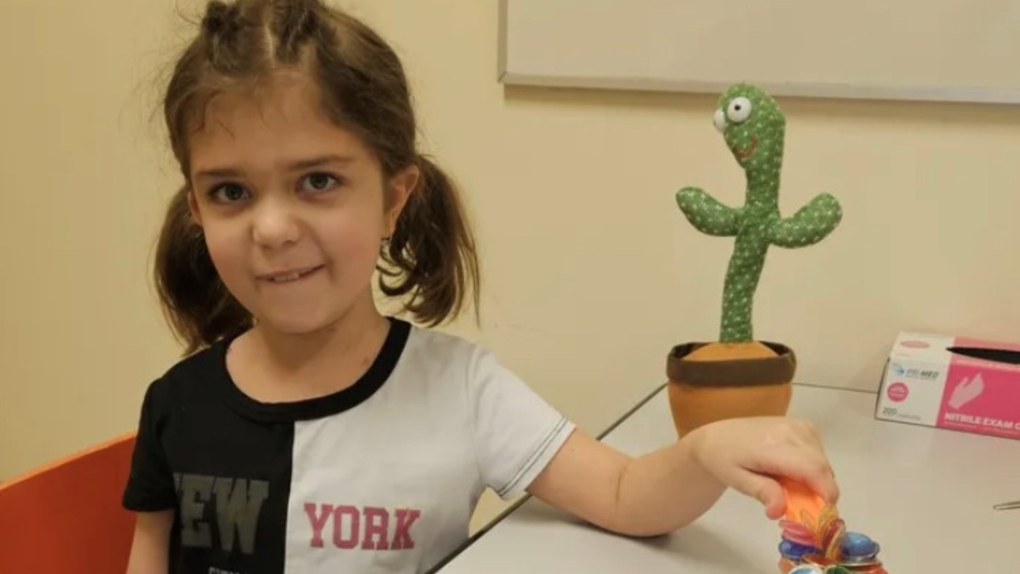‘She can walk’: Calgary girl recovering following successful life-saving brain surgery
An eight-year-old Calgary girl is walking on her own for the first time in several months following the completion of a life-saving brain tumour operation, but more funds are still needed to cover the $150,000 cost of the procedure.
Olivia Danilenka was diagnosed in August of last year with a rare and aggressive brain disease called neurofibromatosis type 1 (NF1).
The disease is most commonly inherited through neurological disorders, affecting about one in 3,000 people worldwide. The tumours of this disorder are non-cancerous, but they grow on nerves, impacting both speech and motor skills.
For Olivia, a tumour in the thalamus section of her brain had doubled in size. A slight pain in her right arm increased to the point that it became completely non-functional, her right leg became increasingly weaker, and her speech was so slurred that it was often unrecognizable.
“We were really scared because there could be very difficult complications, we were starting to lose hope,” said Olivia’s mother Natallia Danilenka.
The only option for treatment in Canada was to have the tumour partially removed, which came with a 30 per cent chance of success.
That’s why Olivia’s family reached out to Dr. Paul Klimo, an experienced surgeon from Le Bonheur Children’s Hospital in Memphis, Tenn., who specializes in brain tumour removals with minimal risks.
The costly procedure was completed on March 5 and it was a success.
“She woke up, she was just trying to catch her breath at first, but her first question she asked us was if she could do her math exercises because she loves to check her memory,” Natallia said.
“She went through all the problems, she did so well, and we were super happy because she can move her hands, she can walk, she can speak. It was so emotional.”
Dr. Klimo managed to remove a five-centimetre tumour from Olivia’s brain following an eight-hour surgery.
“Thank you, Dr. Paul,” Olivia said during a video call interview on Thursday while recovering at a family care centre in Memphis.
The facial drooping on the right side of her face has now significantly reduced, her speech sounds much clearer with less blurring and two fingers on Olivia’s right hand have begun moving unconsciously, marking the first movement in that hand in over four months.
Natallia says she appears to be happier than ever.
“I’ve never seen my daughter this chatty and full of life. Dr. Paul has mentioned that she is very likely to be cured in the future, and these signs are incredibly promising,” she said.
 (Courtesy: Natallia Danilenka)
(Courtesy: Natallia Danilenka)
Thousands of dollars left to pay
Despite the emotional success of Oliva’s life-saving surgery, there are still thousands of dollars left to pay to cover the cost.
Alberta Health says a committee reviews applications for the payment of expenses for insured services outside of Canada, but it’s not known if this surgery could be covered, and it could take several months or a year for the application process to unfold.
According to the Alberta Health website, there is no cure for neurofibromatosis, but treatment may relieve symptoms.
“Some people choose to have large or highly visible tumours removed by surgery,” read a statement from the website.
A GoFundMe campaign to recoup the $150,000 cost of the surgery has raised just over $34,000 as of Thursday.
“We are very grateful to all the people that have helped us,” Natallia said.
“We didn’t expect that much help, maybe $5,000, but these donations are really going to help us a lot to return the loans that we took out to get this surgery.”
Raising awareness for neurofibromatosis
Neurofibromatosis directly affects the nervous system and causes tumours because those diagnosed with the disease have a deletion or modification of their tumour suppressor gene.
The gene is meant to stop tumours from forming, but in this case, the benign cancerous cells can begin to pop up around the body and result in light brown skin spots, bone problems, or learning disabilities.
“So they’re not harmful in the way that cancers are, but that doesn’t mean they’re (not) uncomfortable, they can cause a lot of pain,” said Elana Loftspring, external relations coordinator with the Children’s Tumor Foundation.
“Sometimes Plexi-form tumours wrap around a nerve a certain way that is severely painful, it can also entangle the nerves of the body and they can even bulge out of the body and appear to be growing on the outside, when in fact it’s just on the inside pushing the skin or muscles out.”
Loftspring, who now lives in Houston, Texas, knows all too well about neurofibromatosis, having been diagnosed with the condition at the age of 11.
She underwent a successful brain surgery at the St. Louis Children’s Hospital in 2009 just a few days before her 12th birthday.
 Elana Loftspring had brain surgery for neurofibromatosis at the age of 11. (Courtesy: Elana Loftspring)
Elana Loftspring had brain surgery for neurofibromatosis at the age of 11. (Courtesy: Elana Loftspring)
“I have had more skin tumours pop up because most of those occur when you’re a teenager to adulthood, they look like little bumps or pimples all over the body so it was a struggle in school,” she said.
“But I managed to graduate with honours, I still got a job, it was challenging and NF still affects my life, but just be strong, you’re stronger than you think, we’re born to cope with this and to be able to survive it.”
View original article here Source









